Safety Protocols and Measures for Integrating New Lab Equipment in a Medical Laboratory
Summary
- Ensuring the safety of both patients and healthcare professionals is paramount when integrating new lab equipment into an existing Workflow in a medical laboratory.
- Strict protocols should be followed to properly calibrate, test, and validate new equipment before using it on patient samples.
- Proper training, documentation, and maintenance routines are essential to ensure the efficient and accurate operation of the new lab equipment.
Introduction
Integrating new lab equipment into an existing Workflow in a medical laboratory can be a complex and challenging process. It requires careful planning, coordination, and adherence to strict protocols to ensure the safety of both patients and healthcare professionals. In this article, we will discuss the protocols and safety measures that should be followed when introducing new lab equipment into a medical laboratory in the United States.
Calibration and Testing
Before new lab equipment can be used on patient samples, it is essential to calibrate and test the equipment to ensure its accuracy and reliability. This process involves:
- Calibrating the equipment according to the manufacturer's specifications.
- Performing validation testing to ensure that the equipment meets the required performance standards.
- Comparing the results of the new equipment with existing equipment to ensure consistency and accuracy.
Validation and Verification
Once the equipment has been calibrated and tested, it is important to validate and verify its performance. This includes:
- Testing the equipment with known samples to ensure accurate results.
- Comparing the results of the new equipment with established reference ranges to verify its accuracy.
- Documenting the validation process and results for future reference and auditing purposes.
- The proper operation of the new equipment.
- Safety protocols and measures to prevent accidents and injuries.
- Quality Control procedures to ensure the accuracy and reliability of Test Results.
- Keeping detailed records of the calibration, testing, and validation processes.
- Documenting any maintenance or repairs performed on the equipment.
- Recording any incidents or accidents involving the new equipment for future reference and analysis.
- Performing regular maintenance according to the manufacturer's guidelines.
- Conducting routine checks to ensure the equipment is functioning properly.
- Addressing any issues or malfunctions promptly to prevent disruptions in Workflow.
Training and Education
Proper training and education are essential when integrating new lab equipment into an existing Workflow. Healthcare professionals should receive training on:
Documentation and Record-Keeping
Accurate documentation and record-keeping are crucial when integrating new lab equipment into a medical laboratory. This includes:
Maintenance and Routine Checks
Regular maintenance and routine checks are essential to ensure the efficient and accurate operation of new lab equipment. This includes:
Conclusion
Integrating new lab equipment into an existing Workflow in a medical laboratory requires careful planning, coordination, and adherence to strict protocols and safety measures. By following the guidelines outlined in this article, healthcare professionals can ensure the safety of both patients and their colleagues while maintaining the accuracy and reliability of Test Results.

Disclaimer: The content provided on this blog is for informational purposes only, reflecting the personal opinions and insights of the author(s) on the topics. The information provided should not be used for diagnosing or treating a health problem or disease, and those seeking personal medical advice should consult with a licensed physician. Always seek the advice of your doctor or other qualified health provider regarding a medical condition. Never disregard professional medical advice or delay in seeking it because of something you have read on this website. If you think you may have a medical emergency, call 911 or go to the nearest emergency room immediately. No physician-patient relationship is created by this web site or its use. No contributors to this web site make any representations, express or implied, with respect to the information provided herein or to its use. While we strive to share accurate and up-to-date information, we cannot guarantee the completeness, reliability, or accuracy of the content. The blog may also include links to external websites and resources for the convenience of our readers. Please note that linking to other sites does not imply endorsement of their content, practices, or services by us. Readers should use their discretion and judgment while exploring any external links and resources mentioned on this blog.
